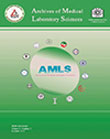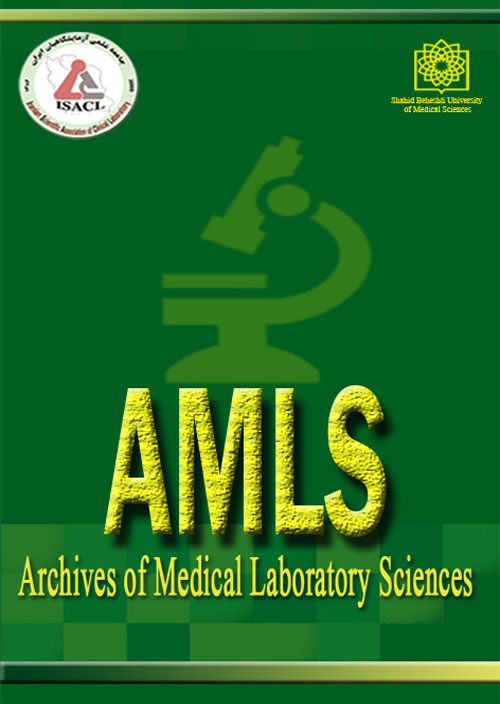فهرست مطالب

Archives of Medical Laboratory Sciences
Volume:1 Issue: 2, Summer 2015
- تاریخ انتشار: 1394/06/20
- تعداد عناوین: 8
-
Page 45BackgroundCCL22 is a chemokine that induces the migration of Th2- and regulatory T cells to the inflammatory sites. The aim of this study was to investigate the association of a single nucleotide polymorphism (SNP), rs4359426, in CCL22 gene, with multiple sclerosis (MS) in patients from southeast of Iran.Materials And MethodsThe blood samples collected from 150 patients with MS and 150 healthy subjects as a control group. The serum levels of CCL20 measured by ELISA and the DNA analyzed for CCL22 polymorphism using PCR-RFLP method.ResultsThere were no significant differences in the frequencies of genotypes and alleles at SNP rs4359426 in CCL22 gene between MS patients and controls. No significant differences also observed between controls and patients with RRMS, SPMS, PPMS and PRMS patterns regarding the genetic variation of rs4359426. In both MS and control groups, no significant differences were observed between subjects with CC, CA and AA genotypes or between subjects with C and A alleles concerning rs4359426 with respect to the serum levels of CCL22.ConclusionThese results do not show any association between the investigated genotypes and alleles at rs4359426 in CCL22 gene with MS or its patterns in MS patients. The serum levels of chemokine did not also influence by genetic variation of SNP rs4359426.Keywords: Multiple sclerosis, CCL22, Chemokine, Polymorphism
-
Page 51BackgroundMajor depressive disorder is a mental disorder characterized by a pervasive and persistent low mood that is accompanied by low self-esteem and loss of interest or pleasure in normally enjoyable activities. Depression is associated with multiple immunological disorders. Aim of the present study was to determine correlation between percentage of circulating NK cells and major depressive disorder.Materials And MethodsPatients older than 18 years with the desire to participate were enrolled in this study. For depression evaluation, we used the Hamilton Depression Rating Scale and for determination of percentage of NK cells in peripheral blood, flow cytometry method was used.ResultsOur results showed that in patients with major depressive disorder, numbers of circulating NK cells have significantly reduced.ConclusionAccording to our findings, depression is associated with immune suppression. NK cells are important in early phase of immunological surveillance versus viral infections and tumors. Indeed, depressive patients are susceptible to cancers and infections.Keywords: major depressive disorder, natural killer cells
-
Page 56BackgroundCrimean-Congo Hemorrhagic Fever (CCHF) is a severe tick-born illness caused by the CCHFV. Ruminant animals are the main host to ticks, and ticks are a vector of CCHF. Therefore, this survey was carried out in 2013 on ticks of Khouzistan province, in the Southwest of Iran, to specify tick species parasitizing live stocks and their seasonal population dynamics.Materials And MethodsDuring a survey for possible tick population of Khouzistan province as one of the critical epidemiologic areas in Iran, ticks were collected from the body of infested animals by a tweezer and then transported to the laboratory of Medical Entomology, School of Public Health, Tehran University of Medical Sciences and finally were identified to genus and species level using identification key.ResultsA total number of 372 hard ticks were collected randomly from 458 live stocks in 7 different cities. Shosh was the most infected city in this study. Ticks infection rate on sheep, goat and cow was 84.12%, 12.69 % and 3.17%, respectively. In the study 2 genus and six species of hard ticks were identified including Rhipicephalus sanguineus, Hyalomma anatolicum, Hyalomma asiaticum, Hyalomma sp., Hyalomma marginatum and Rhipicephalus turanicus. Rhipicephalus sanguineus was the most frequent species in the study area.ConclusionOutbreak of human cases of CCHF in parallel with ticks distribution shows the importance of this survey. Despite of studies that have been done on ticks distribution and ticks infestation in Iran recently no study has been conducted yet about this field in this province.Keywords: CCHFV, Ixodidae, Tick, Rhipicephalus, Khouzistan
-
Page 61BackgroundMigraine consisting of migraine with aura (MA) and migraine without aura (MO) is a painful neurovascular disorder affecting approximately 16% of the general population. A combination of genetic and environmental factors is involved in the pathogenesis of migraine. The MTHFR enzyme is involved in homocysteine (Hcy) metabolism and it has been reported that 1298 A to C and 677 C to T mutations in the MTHFR gene are associated with an increased in plasma Hcy levels. Hcy is a highly reactive amino acid and causes endothelial injury. Because a plausible theory about vascular impairment in migraine, it is considered that mutations in MTHFR gene and folate metabolism are associated with migraine.Materials And MethodsIn total, 75 patients with migraine (24 with MA and 51with MO) in accordance with the IHS criteria participated in this case-control study. Control group were 128 normal matched healthy subjecys who selected from same region without history of migraine or other neurologic disorder after interviewing and examining by a physician. Mean age at entry was 36.42±9.6 and 31.64±8.9 years old in migraine and control group respectively. MTHFR polymorphisms were investigated by PCR-RFLP.ResultsGenotypic results indicated that the prevalence of the MTHFR 677TT genotype in migraine subjects was higher than control (17.3% and 3.1% respectively, P0.001).ConclusionIt seems that MTHFR C677T is a potential genetic risk factor for migraine attacks, both in MA and MO subclasses in Iranian population. C677T and A1298C joint effect could amplify the potential influence of each SNPs.Keywords: Genetic, MTHFR, Migraine, Iran
-
Page 67BackgroundAflatoxin-contaminated feed cause mortality, suppression of the immune system, reduced growth rates and losses in feed efficiency. An experiment was conducted to evaluate the ability of different levels of sodium bentonite (SB), Silybummarianum seeds (SMS) and their combination for reducing the adverse effects of Aflatoxin B1 (AFB1) in broiler chicks.Materials And Methods224 male Ross 308 broiler chicks in a completely randomized design based on factorial experiment (2 × 2 × 2) with 2 levels AFB (0and 500ppb), 2 levels SMS (0 and 0.5%) and 2 levels SB (0 and 0.5%) with 8 treatments, 4 replicates and 7 chickens per each were used from one to 24 days age.ResultsThe results showed that compared with the control group, diets contaminated with AFB1 increased the aminotransferase (AST) and gammaglutamyl transferase (GGT) but decreased serum total protein (TP) and Albumin significantly (P≤0.05). SB with AFB caused a significant decrease in serum AST and lactate dehydrogenase (LDH) levels and increase Albumin significantly (P≤0.05). SMS with AFB causes a significant decrease in serum Urea, GGT and LDH levels significantly (P≤0.05). Broiler chickens fed diets containing SB, SMS and AFB1 their biochemical indices (AST, GGT, Albumin and total protein) were improved significantly compare to basal diet contaminated with aflatoxin (P≤0.05).ConclusionThe results showed that the combination of SB and the SMS were more beneficial as separate application of them for decreased toxic effect of Aflatoxin B1 in diets.Keywords: Aflatoxin B1, Blood parameters, Milk Thistle, sodium bentonite
-
Page 74Nowadays, the presence of HBV DNA in the absence of HBsAg; occult hepatitis B infection; (OBI), is a known clinical entity along with the rapid influx of research being conducted on its clinical relevance. Biologists and clinicians alike have a recent-standing interest in this regards. OBI has been described in several clinical settings. However, the data on its prevalence among immunized and non-immunized healthy general population, in particular, among health care workers (HCWs) is ambigous. This review attemps to explore the significance of OBI in vaccinated groups as a special subject. The prevalence of OBI among general population, vaccinated children/general population and health care workers were: 157 (5.2%), 222 (6.7%) and 33 (1.8%), respectively. The prevalence of anti-HBc among OBI-positive subjects were: 64 (40.7%), 133 (82.7%) and 27 (81.8%), respectively. OBI is partly prevalent in general population and in vaccinated individuals, especially in those who born to HBsAg positive mothers. HBV serological surveys are not enough adequate and sensitive to rule out the presence of HBV DNA. For high-risk groups (subjects born to HBsAg mothers, health care workers, isolated anti-HBc, etc) sensitive molecular tests based on real time PCR should be applied for a proper diagnosis.Keywords: occult hepatitis B infection_general population_Health care workers_HBV vaccine
-
Page 84BackgroundDermatomycoses are a major public health problem. Tinea cruris is a form of Dermatomycoses.Tinea cruris is a common infection in the groin area, genitals, pubic area, perineum and perianal skin.The purpose of thisstudywas to investigate the cutaneous fungal infections among students in a school dormitory.Materials And MethodsThe study was performed on 110 male students dormitory aged between 18 to 28 years.From the specimens obtained, direct preparations were made using %10 potassium hydroxide and cultured on sabouraud dextrose agar containing 0.05 mg/ml chloramphenicoland 0.5 mg/ml cycloheximide (Scc). Identification of fungi was performed according to morphologic and microscopic growth of the colonies and using slide culture method.Results17 people out of 110 individuals were diagnosed with cutaneous fungal infections. Six people were diagnosed with dermatophytosis. All cases of dermatophytosis were Tinea cruris. Epidermophyton floccosum, the anthropophilic species, was only isolated dermatophyte.The prevalence of Tinea cruris was 5.5% and the Prevalence of Pityriasis versicolor was 4.5%.ConclusionThe most important source of transmission of anthropophilic dermatophyte species was by men to men.The results of this study is similar to most other studies in Iran and other countries. In addition to treatment, other necessary steps should be applied in order to prevent infection and reduce the risk of pathogens.Keywords: Dermatomycoses, Dermatophytosis, Epidermophyton, Tinea cruris
-
Page 88BackgroundDemodicosis in humans was caused by two species of Demodex called folliculorum and brevis. The disease is seen in male and female. Although, there is no clinical symptoms in individuals with normal immunity system, but in many cases, dermatitis, rough, dry and scaly skin rosacea, particularly asymmetrical papulopustular or granulomatous variants and in some cases, perioral dermatitis, blepharitis [inflammation of the eyelid margins] are observed. In this report 16 cases of demodicosis diagnosed in recent years are presented.
Cases: Suspected patients with dermatophytosis who referred to the laboratory were examined in this study. In sampling, slide preparation and microscopic evaluation Demodex species was observed. In two cases, co- infection of dermatophytosis and demodicosis were demonstrated. Seven [43.75%] out of 16 patients were male and nine [56.25%] were female. In this study, 16 persons [4- 52 years old] were considered. None of the patients had any information about their disease and the cause .The patients were referred to the laboratory for fungi examination.ConclusionDemodicosis is a cutaneous parasitic disease and it is necessary that the parasitologists and mycologists consider the demodicosis during the sampling, preparation of slide and microscopic examination of cutaneous lesions.Keywords: Type Demodex folliculorum, Demodex brevis, demodicosis


